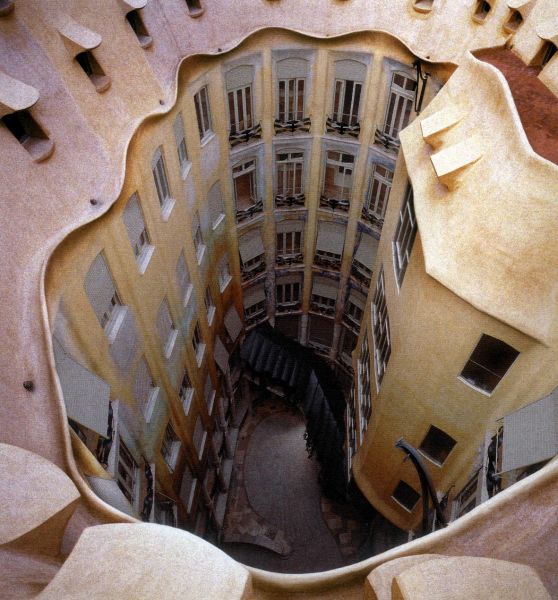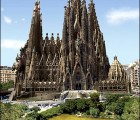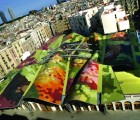La Pedrera - Casa Milà by Antoni Gaudí in Barcelona (Spain)
Building name: La Pedrera - Casa Milà
Architect: Antoni Gaudí
City: Barcelona
( Spain)
Spain)
La Pedrera, also known as Casa Milà, stands as an icon of Barcelona's architectural landscape and a masterpiece of Antoni Gaudí's genius. This extraordinary building, completed in 1912, is a UNESCO World Heritage Site and a symbol of the city's Modernisme movement. Here's a comprehensive look at La Pedrera, its history, architecture, and significance:
History and Context
Commissioned by Pere Milà i Camps and his wife, Roser Segimon i Artells, La Pedrera was intended to be a luxury apartment building. Located on the famous Passeig de Gràcia, it was one of Gaudí's last major works before dedicating himself entirely to the Sagrada Familia.
Architectural Style
La Pedrera exemplifies Gaudí's distinctive architectural style, which is characterized by organic forms, flowing lines, and a deep integration with nature. Gaudí was inspired by natural shapes, such as caves, waves, and shells, which are reflected in the building's design.
Undulating Facade
The facade of La Pedrera is perhaps its most striking feature. It undulates like a living organism, with sinuous lines that seem to breathe and move. The stone facade appears almost like a swirling ocean wave frozen in time, with intricate balconies and windows seamlessly integrated into the flowing lines.
Stone Quarry Inspiration
The name "La Pedrera" means "the stone quarry," a fitting name given the building's appearance. Gaudí used local stone, mostly limestone, in its construction. The facade, with its rough-hewn appearance, looks like it was sculpted from the very stone quarries that dot Catalonia's landscape.
Rooftop Sculptures and Chimneys
The rooftop of La Pedrera is a surreal landscape of sculptural forms, an otherworldly garden of chimneys, ventilation towers, and stairwells. Each chimney is a unique piece of art, with whimsical shapes resembling medieval knights, warriors, and even surrealist creatures.
Espai Gaudí Museum
Today, La Pedrera houses the Espai Gaudí Museum, located in the attic. This museum offers insight into Gaudí's life, work, and creative process. Visitors can explore scale models, original drawings, and multimedia exhibits that provide a deeper understanding of the architect's visionary ideas.
Courtyard and Interior
The interior of La Pedrera is no less impressive than its facade. The central courtyard, known as the "patio de luces" or "light well," is a grand space with white walls, curved lines, and a skylight that floods the area with natural light. This design maximizes ventilation and illumination for the apartments.
Apartments and Interior Design
Originally, La Pedrera housed 20 luxury apartments spread over its five floors. Gaudí meticulously designed the interiors, incorporating features such as wooden doors, ornate ironwork, colorful tiles, and curved walls. The apartments were designed to prioritize natural light and ventilation, with many rooms overlooking the central courtyard.
Cultural and Symbolic Significance
La Pedrera is not just a building; it's a symbol of Catalan identity, innovation, and artistic expression. Gaudí's use of natural forms, sustainable design principles, and attention to detail reflects his deep connection to Catalonia's landscape and culture.
UNESCO World Heritage Status
In 1984, La Pedrera was designated a UNESCO World Heritage Site, recognizing its outstanding universal value. It stands as a testament to Gaudí's architectural genius and the Modernisme movement, which sought to create a unique Catalan style rooted in tradition yet forward-looking in its innovation.
Conservation and Restoration
Over the years, La Pedrera has undergone extensive conservation efforts to preserve its architectural integrity. The building has been restored to its original glory, with meticulous attention to detail to ensure that Gaudí's vision remains intact for future generations to admire.
Tourist Attraction and Cultural Center
Today, La Pedrera is open to the public for tours, allowing visitors to explore its fascinating architecture, history, and cultural significance. It remains one of Barcelona's most popular tourist attractions, drawing millions of visitors each year who come to marvel at Gaudí's masterpiece.
Legacy and Inspiration
La Pedrera continues to inspire architects, artists, and designers around the world. Its organic forms, innovative design solutions, and integration with nature set a precedent for sustainable and visionary architecture. Gaudí's legacy lives on in the building, serving as a reminder of the power of art and architecture to shape the world around us.
La Pedrera - Casa Milà stands as a testament to Antoni Gaudí's brilliance and the Modernisme movement in Catalonia. Its undulating facade, rooftop sculptures, intricate interiors, and cultural significance make it a must-visit destination for anyone interested in art, architecture, and history. The building's designation as a UNESCO World Heritage Site ensures that it will continue to inspire awe and wonder for generations to come, preserving Gaudí's legacy as one of the greatest architects of all time.
Visits of La Pedrera - Casa Milà
 | Passeig de Gracia, 92
08008 Barcelona |
Nearest buildings:
-
Casa Batlló (Barcelona)
Casa Batlló, one of Barcelona's most famous landmarks, is an architectural masterpiece designed by the renowned Catalan architect Antoni Gaudí. Located on the Passeig de Gràcia, this building is a prime example of Gaudí's unique style and innovative approach to architecture. Here are some key details about Casa Batlló:
Architectural Style
Casa Batlló is a prime example of Modernisme, a Catalan version of Art Nouveau, which was a popular architectural style in Barcelona at the...

-
Casa Vicenc (Barcelona)
-
La Sagrada Família (Barcelona)
-
Santa Caterina Market (Barcelona)
The Santa Caterina Market, designed by the architect Benedetta Tagliabue and the studio Miralles Tagliabue EMBT, is a vibrant and modern market located in the heart of Barcelona, Spain. Here are some key details about the market and Tagliabue's design:
Renovation Project
The Santa Caterina Market is one of Barcelona's oldest markets, dating back to the 19th century. In 1997, it underwent a significant renovation project led by the architectural firm Miralles Tagliabue EMBT, with...

-
Palau Güell (Barcelona)
-
Colegio de las Teresianas (Barcelona)
-
Torre Glories (Barcelona)
I'll cover the architecture of Torre Glòries, as they refer to the same building in Barcelona, Spain, designed by architect Jean Nouvel.
Torre Agbar / Torre Glòries:
Torre Agbar, later renamed Torre Glòries, is a striking skyscraper located in the Poblenou neighborhood of Barcelona, Spain. Designed by the renowned French architect Jean Nouvel, the tower was completed in 2005 and quickly became one of Barcelona's most iconic landmarks. Here are some details about its...

-
Montjuïc Communications Tower (Barcelona)
-
Torre Bellesguard (Barcelona)
-
Cripta Gaudi (Barcelona)











